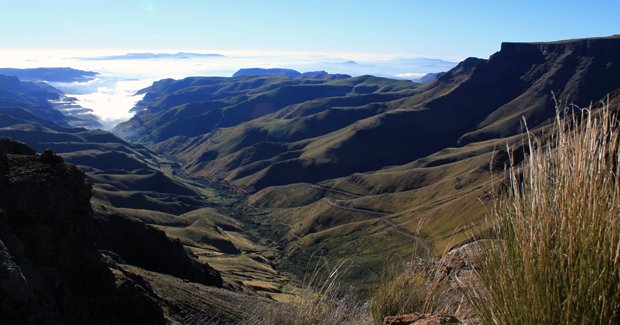AG African safari: the mountain kingdom

AG Society administrator Kylie Piper finds a surprising country in Lesotho.
LESOTHO DISPELS EVERY IDEA I have had about Africa. There are no veldts or savanna plains here, no mega fauna grazing in game parks. Here there are 3000 m peaks and rolling mountain ranges that seem to go on forever.
LAUNCH THE GALLERY
Our introduction to Lesotho is via the Sani Pass, 11km of snaking dirt road that winds its way up through the mountains. Our exit from South Africa into the smallest nation on the African continent is perfunctory. Another stamp in the passport, recite the vehicle registration and off we go. I guess there is no point for too many formalities here; the only exits from the country are back into South Africa.
From the border post we cross over into no man’s land and head upwards into the clouds. We will ascend to a height of 2865 m before we gain entry into Lesotho dubbed Africa’s mountain kingdom, with all its lands above 1500 m in height.
Sani Pass is the only access to the eastern side of Lesotho. It was first traversed in a vehicle in 1948 by Godfrey Edmund who took a staggering nine hours to complete the journey. It’s low range and slow going for all vehicles up the steep incline and around hair pin turns, for all except the taxis that is – mini-vans crammed with 20 or so people that exude black smoke as they motor past at this altitude. There is no chance that they will stop or adhere to the common courtesy of the pass.
As we make our way along the pass, an icy cold wind picks up, battering the vehicle and making the grass along the hillsides sweep and sway like a green and gold carpet in the slowly vanishing sunlight. The convoy of vehicles is behind us and we can see the road snaking away in the distance through the valley gorge as we reach the top with a sigh of relief.
After an hour on the pass, through 11 km of no man’s land, we check into the final country on our four country tour. We alight from our vehicles to be greeted by men slaughtering a goat on the steps of the border crossing, the only place for miles where this kind of task could be performed out of the chilling wind, but the customs officials don’t seem to mind. We enter this tiny country and retreat to the Sani Top chalet for hot chocolate and gluvein to take away the sting of the icy wind – more akin to a European ski chalet than a tour in Africa.
The geology of Lesotho is astounding. Over millions of years of volcanic activity, kilometers of basalt was laid down, creating a new earth surface that would eventually be gouged by snaking rivers and erosive winds, building the cavernous gorges that remain today. Waterfalls and streams dot the countryside, ice and snow are still present on the highest peaks.
Yet all across these high mountain ranges small villages are found, with huts and stores and the occasional school. Agricultural plots have been tilled into the hillsides, green and brown streaks across the hilly terrain. But the most interesting aspect is the tiny huts and stone kraals that dot the hills, some barely visible up in the highlands. These are used by the herd-boys of Lesotho. Boys, some as young as 12 or 13, are sent off to guard the family’s sheep and goats for six months each year – part of the initiation ritual that is a strict rite of passage in the region. The boys must fend for themselves, building their own huts and finding their own food, not allowed to return to the village for the duration of the period. Following this trial, they will attend another ritual, circumcision, after which they will officially become a man and leave all the trappings of boyhood behind.

A herds-boy, weaving a basket in Lesotho (Photo: Kylie Piper)
We shiver inside our vehicles; it was a chilly 13 degrees when we left the warmth of the lodge. With beanies, boots and jackets we have taken on our journey. The herd-boys we pass on the way have nothing like these luxuries – a traditional Basotho blanket over underpants and a worn out pair of gumboots is all that protects them from the icy winds.
We stop to speak to one of the herd-boys and look inside his hut. He seems happy to have visitors and laughs at the photos we take of him, willingly accepting our gifts of food. His hut is bare, but for a few scraps of wool on the ground and some ash where the fire has been. The door is barely large enough for an adult to fit through, but inside it is warm and sheltered from the winds. He will build a fire again this night and herd all of the smallest lambs and goats into the hut with him, to protect both them and himself from the cold.
The land here is green and the sheep that line the hills are fat and covered in thick wool. We see herd-boys mustering their small herds, walking them to the communal shearing sheds we pass on our travels. Fresh water flows freely down the streams and the children laugh and wave at us as we drive past. This is not a land of famine or dust; it is a land of plenty where the people have only what is needed and everything is used.
RELATED ARTICLES
AG Society Galapagos expedition blogs

